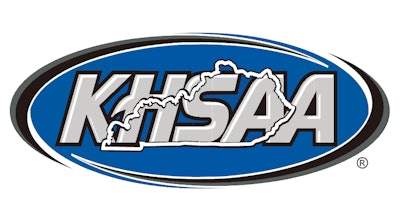
A lawsuit filed Friday in Kentucky's Jefferson Circuit Court claims a Trinity High School football player was verbally abused by his position coach and forced to run extra while showing signs of heat stroke last July.
As reported by Louisville Courier Journal, the suit alleges other team staff and athletic trainers did nothing to come to the player's aid.
The suit names the player only by his initials, but in previous Courier Journal reporting and in a public Facebook post from his family, he was identified as Nathan Rader.
The 20-page lawsuit, filed by his mother, Jami Rader, alleges Trinity High School, the Trinity High School Foundation, the Roman Catholic Bishop of Louisville and KORT Physical Therapy were negligent when they failed to use available equipment to treat Rader’s heat stroke and failed to comply with mandatory state athletic association policies and state law.
The Courier Journal requested comment from Trinity's president Rob Mullen, the Archdiocese of Louisville and KORT.
A KORT representative said the company does not "comment on pending litigation." Mullen and archdiocese did not immediately respond.
According to Courier Journal investigative sports reporter Stephanie Kuzydym, who focuses on the health and safety of athletes, more than 30 minutes after Rader's collapse, his core temperature was still at 107.5 degrees, per the suit, which claims he was never aggressively cooled as required by Kentucky High School Athletic Association policy and state law.
Under the KHSAA's 2024-25 schedule for football, athletes could practice in a helmet and shoulder pads through July 31. They could move to contact and full gear on Aug. 1.
"The junior was suffering from exertional heat stroke, the same thing that took the life of former NFL player Korey Stringer in 2001," Kuzydym reported. "Stringer was never aggressively cooled. His temperature was 108.8 degrees when he arrived at the hospital after collapsing during practice."
Symptoms of exertional heat stroke include lack of coordination, collapse, irritability, confusion or disorientation, according to the Korey Stringer Institute, which was created after Stringer's wrongful death lawsuit with the NFL was settled.
Rader, the team's second-string center, was rushed to Norton Children's Hospital, where he remained unconscious for several hours, but survived. He suffered kidney, heart, liver and other organ damage as a result of the heat stroke, according to the lawsuit.
During a morning practice on July 31, the first-string center did not practice. Rader took reps as both the first- and second-string center — around 50 total.
“Additionally, the team’s practice the day before involved a heavier practice load for players than normal,” the suit states, as reported by the Courier Journal.
It claims Rader was visibly struggling — “so much so that some teammates became worried about him.”
The lawsuit alleges Rader took a knee, then collapsed to the turf. His position coach told him if he didn’t get back on a knee, he’d never play for the varsity team again. As Rader attempted to get back to a knee, he again fell to the ground, before being helped to the sideline, where he lost consciousness.
The lawsuit details two meetings the Raders had with Trinity.
The first, on Aug. 15, was with Mullen, head coach Jay Cobb and athletic director Sean Duggins regarding the "personal nature of Coach Leslie's insults."
On Aug. 18, the staff attempted to have a meeting with Rader without his parents. When Rader's father found out, he showed up to the meeting, according to the lawsuit.
During that meeting, according to Kuzydym's reporting, Leslie apologized to Rader for his conduct during the practice. The lawsuit says near the end of the meeting, when it was just the head coach, father and son, Cobb said, "I've been telling [Coach Leslie] for the last seven years that he's got to change the way he talks to these kids."
Leslie was suspended for three games. He was still allowed to attend those games in the press box, according to the suit.
In the six months since Rader's collapse, the lawsuit says the teen has "had to fight for his life on two separate occasions ..."
The Courier Journal requested EMS and 911 reports through Kentucky's open records law.
The 911 call went out at 10:20 a.m. Records revealed it took St. Matthews Fire & EMS nearly nine minutes to arrive to Trinity High School's football field.
"There’s nothing you can do?" the caller asked 911. "This kid's out. You can’t tell these people to go faster?"
Although St. Matthews Fire & EMS Station 46 is a half mile from the Louisville Catholic high school, the medic unit, Medic 148, dispatched that day was from Station 48 in Lyndon, more than 3 1/2 miles from the field.
The reports also revealed that EMS began an EKG, or electrocardiogram, of Rader's heart at 10:35 a.m. and provided advanced life support.
Based on EMS reports, Rader was in critical condition as a Level 1 emergency, Kuzydym reported.
The Courier Journal investigated school sports safety in 2023 in its national-award winning project "Safer Sidelines." It took an in-depth look at sudden death in youth sports and the gold standards of sports medicine.
According to Kuzydym, there are four leading causes of death in high school athletes, known as the four Hs: head (trauma), heart (sudden cardiac arrest), hemoglobin (blood) and heat.
There are also four gold-standard tools for sidelines:
- A venue-specific emergency action plan (a piece of paper that informs what to do in case of an emergency at a specific sports venue);
- A cold-water immersion tub (for cooling an overheating athlete);
- An AED (or defibrillator, which will only deliver a shock if a heart is not in rhythm);
- A wet bulb globe thermometer.
The Courier Journal requested information regarding Trinity's gold standard sports medicine tools. Under Kentucky law, because it is a private school, it is not required to provide the information.
Mullen told the Courier Journal in a January email that Trinity's cold tub is "located adjacent to the field in the sports training facility." The school also has 10 AEDs, Mullen said, including one on the field at football practices and games.
Mullen provided the Courier Journal with a copy of the school's emergency action plan (EAP) for Marshall Stadium. But, the suit claims, the school broke the state's EAP law by not including a plan for treating an athlete whose condition "may deteriorate rapidly."
Mullen also said an athletic trainer did take the WBGT on July 31, and it rose from 69.8 degrees at the start to 84.5 degrees at the end of practice
The KHSAA mandates if a WBGT temperature at a sporting event is between 82.1 and 87 degrees, a cold water immersion tub or TACO "must be filled with water ... and accessible for cooling within five to 10 minutes of the practice," the suit states.
In response to whether the cold tub or AED were used that day, Mullen said in the January email: "I cannot comment on the specifics of this incident. Thanks for understanding."
"The gold standard of an overheating athlete is to get their core body temperature — through either cold-water immersion (like a 200-gallon horse trough that’s filled with water and ice) or the TACO method (a tarp with water that is sloshed back and forth to cool the body) — and continuing cooling until their internal core temperature below 102.5 degrees within 30 minutes and before allowing them to be transported by EMS," Kuzydym reported. "The standard is known as 'cool first, transport second.' "
“Any kind of heat illness or heatstroke is 100% preventable,” Jordan Clark, a climatologist and a senior policy associate for the Heat Policy Innovation Hub at Duke University, told USA TODAY following the deaths of at least eight high school athletes in August 2024, Kuzydym reported.





































